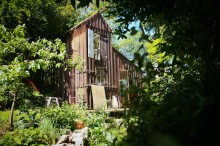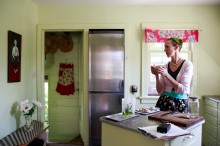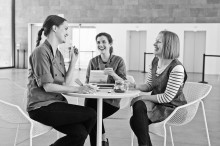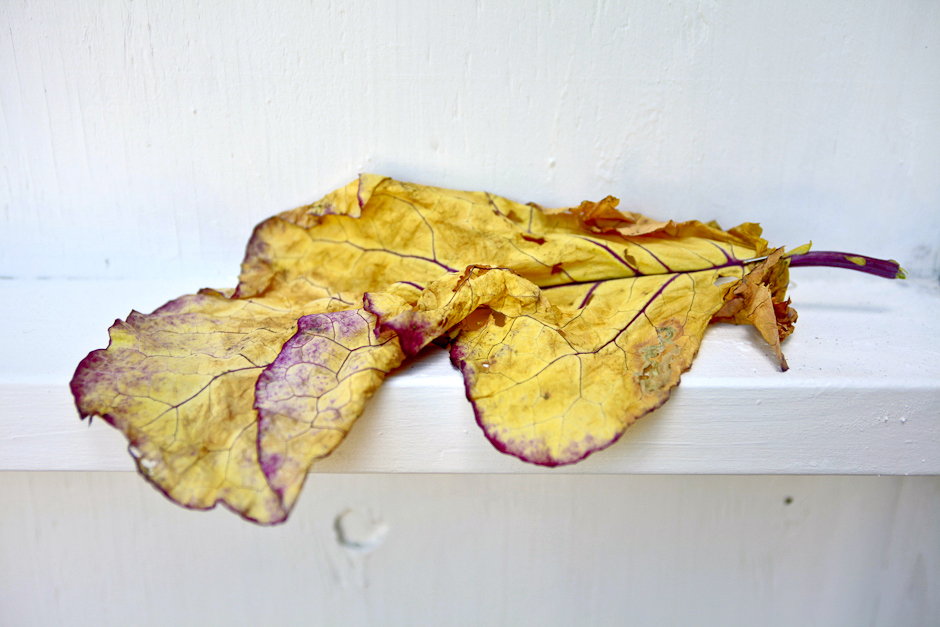
Sasha Duerr

“Immersion”…That is the first word that comes to me when I think of our visit with Sasha, and true to how word association games run and the erratic, unexpected links that occur, the next word that pops into my head is “baptism.” Which is not exactly the place I thought I would start an introduction on Sasha’s work with textiles and organic dyes and fibers, as Christianity or religion didn’t come up once in our visit. But the word is now stuck in my head, which calls for a little research work on Google— Apparently, the English verb “baptize” is derived from the Greek word baptizein which means “dip, plunge” and although it does not exclusively mean dip, plunge or immerse, it is used with literal and figurative meanings such as “sink”, “overwhelm”, “go under”, “draw from a bowl.”
This etymological history surprised me… essentially, the whole of my experience with Sasha can be found in the significance of baptizein. Its meaning hints not only at some of the practices and tools in her dye-extraction process, such as the physical act of dipping and submerging of textiles into bowls and vats of recipes using everything from hibiscus to olive leaves, but it also conveys the immersive, overwhelming experience of talking to Sasha about permaculture practices and philosophies, natural dye processes, and the spectrum of living color in even the most ordinary of plants. She is nothing short of enthusiastic and her stories, inspirations, and explanations run a mile a minute. While we talked in her backyard with her adorable two young children running about, I felt I was barely able to grasp what she had just said before she was on to the next topic. If anyone lives and breathes what they believe in, it is Sasha. It’s a powerful and intoxicating thing to witness someone carving out a personal, creative, and work life that is so fully entrenched in, so committed to their philosophies.
Bill Mollinson, who is considered to be the father of permaculture, defined it as “a philosophy of working with, rather than against nature; of protracted and thoughtful observation rather than protracted and thoughtless labor; and of looking at plants and animals in all their functions, rather than treating any area as a single product system.” And true to this approach, I believe Sasha looks at the world around her, the weeds in the sidewalk, the water running from her tap, and the soil beneath her feet and considers not only all their known properties and functions, but also all the still unseen possibilities in them. And then she makes it her business to draw these possibilities out.



How would you describe your subject matter or the content of your work?
My work with plant-based color making is a cross-pollination of art and environmental systems thinking. I am often working with biodiversity, expanding the senses through living color palettes, and the social practice that supports it.
What mediums do you work with?
I work with plant color, often experimenting with weeds, waste, biodiversity, seeds, soil, alchemy, collaboration and the art of gathering. I create color (installations, paintings, textiles) for experimentation, mapping, and cultivating community.
Writing and documenting through photography often become a big part of my process. I am also the founder of a textile and ecological fashion non-profit called Permacouture Institute.


You use natural dyes in your work, how have you created or discovered these organic recipes?
It is tragic but true, that we are on the brink of major losses in both cultural memory and biodiversity. As we are often out of sync with our natural environment, learning to identify plants of this world, the pleasure of growing one’s own food, or how to create a color palette ‘from soil to studio’ are concepts directly related to eco-literacy. The more I experimented in my backyard, kitchen and urban sidewalk, the more I realized how accessible the art and craft of creating plant-based color actually is.
I grow or forage for waste or weed materials in my Oakland/Berkeley neighborhood and often use plants directly, rather than extracts, and through this process I learn more about life cycles, seasonal availability, color potential, etc. It’s through this contextual knowledge that I plan most of my projects – much like planning a menu around seasons, availability and potential.
The future of the creation of color needs to be diverse, both in terms of usage of the color on the personal or industrial level, the expectations, and the lifespan. I am fascinated in my art making with the idea of variation in living color palettes, how we can curate and frame natural color in contemporary light, and what working with colors in this way lends itself to lessons in impermanence.
There is a larger and broader conversation occurring in the industry of color (for fashion and textiles) often surrounding stability and frustration of scalability and lasting “permanence.” Having grown-up around tropical/Hawaiian plant culture and the incredible skill, craftsmanship and cultural identity that comes with floral and flower creations, most often meant to be enjoyed in the nowness of being and acceptance that the whole plant will fade away.
Again and again I’ve found that so much of discovering new colors and experimenting with plants is set in openness. Much of the alchemy of the process lays in elemental factors, soil quality, ripeness, season, Oakland tap water, and your own patience and participation. Enjoying the joy of making- as much and more than the results-is often the sweetness that keeps me wanting to discovery more.


Besides your art and design practice, are you involved in any other kind of work?
I am an Adjunct Professor in the Textile Program at CCA, as well as in the MFA program. My classes have a focus in “soil to studio” practices. Last spring I taught a graduate seminar called “Spring Gleaning” which focused on marginal color making from urban weeds and waste with a strong community lens, which I am particularly excited about.
I am also an advocate for the slow textile movement writing, designing curricula and workshops on topics associated with ecological thinking, art, design and inspiration toward new ways of working and thinking about color.
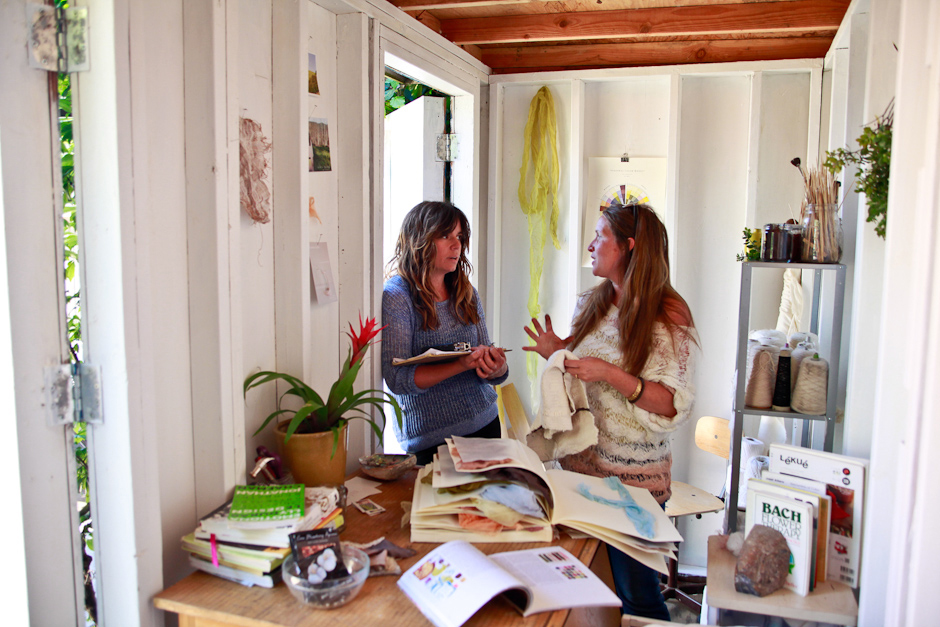



What are you presently inspired by— are there particular things you are reading, listening to or looking at to fuel your work?
I am consistently inspired by holistic practices and learning in a multi-disciplinary way. I love working with a wide range of artisans who also share my love of plants, such as chefs, perfumists, herbalists, botanists…
I’m always enthralled by one or two new plants… I’ve been experimenting quite a bit with local plants that may blend into our sidewalks, for instance manzanita and jade, a native and a succulent plant common to the Oakland/Berkeley border where I live and teach. It is often through teaching and working with others that the experimentation is encouraged. We made some awesome color range discoveries in the “Soil to Studio” class I teach at CCA this spring, many from overgrown plants on campus, or weeds.
I have since started experimenting with the first plant I ever got in San Francisco, a large Jade from a Mission yard sale. I now have several generations of pots later, as well as the original tree. It is literally my anchor plant and has moved with me everywhere. The colors are dark blacks, to purples and shell pinks. I am just awed by the fact that you can live with a plant in your home for 14 years and literally have no idea of the depth of how amazing it is.

What does having a physical space mean for your process, and how do you make your space work for you?
I’ve always wanted to have my work take place primarily outside. I feel very lucky that the nature of my practice IS nature. I love the fluidity and challenges of place-based making.
We recently moved into this house that my husband has owned for several years and we are working on it and fixing it up, slowly turning the double lot into an urban farm. For my work space (being a plant dyer and textile artist) it’s very helpful to have accessibility in gathering and growing plants, connection to the outdoors and daily awareness of seasonal change, and practically speaking, direct access to basic outdoor ventilation, natural light, compost, and water.



Is there something you are currently working on, or are excited about starting that you can tell us about?
I am in the early stages of beginning a second book on plant dyes and working with color from a very visual, seasonal, and socially engaged practice. I am excited to experiment with and expand the sensory color palette.
Do you see your work as relating to any current movement or direction in culture?
Living color, slow fashion and textile ecology, alchemy, and cultural practice…Creating an experience, and bringing the art of color-making to the next level. I see an urban atlas of color making emerging and an art movement surrounding how we relate to our environments, to the mundane, to the invisible social and ecological fabric that supports the process.
I am also seeing that the new wave (and new new wave as demonstrated in my students) of textile art and cultural/social practice with sustainable art and design is emerging quite verdantly. This is a really interesting and exciting time.



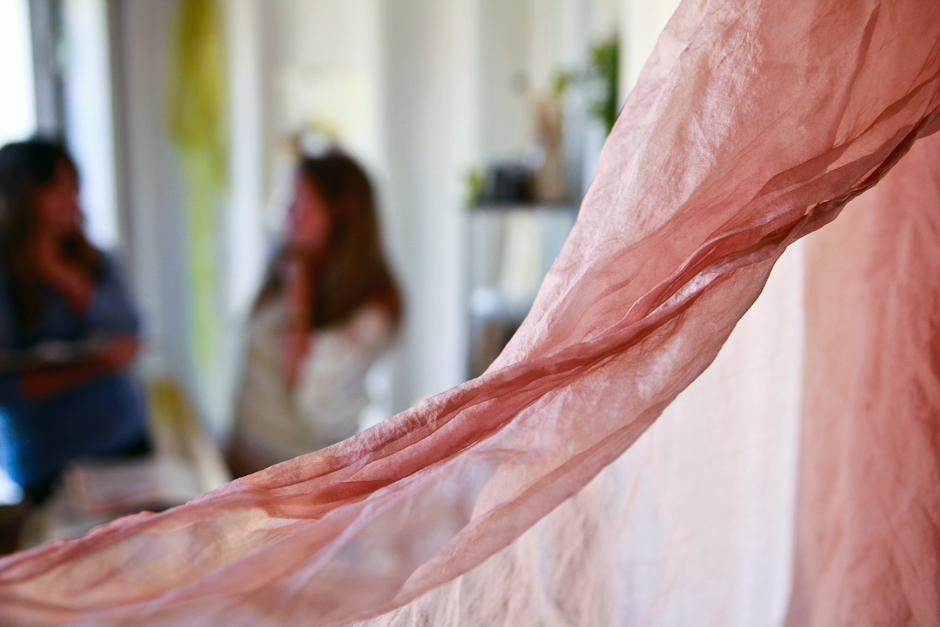
What do you hope your work will accomplish? How do you want people to be affected?
My core work is focused on the cross-pollination of contemporary art, fashion, textiles, and environmental systems thinking. Through experimentation with weeds and food waste, and the biodiversity of local and seasonal plant-based dyes I hope to share the relationships, and expand ideas of nature and nurture through revival of plant and place-based color recipes.
I want my work to inspire an appreciation and awe for the natural world, a curiosity, and a deeper desire to sync-up, notice newness, elevate what’s possible.
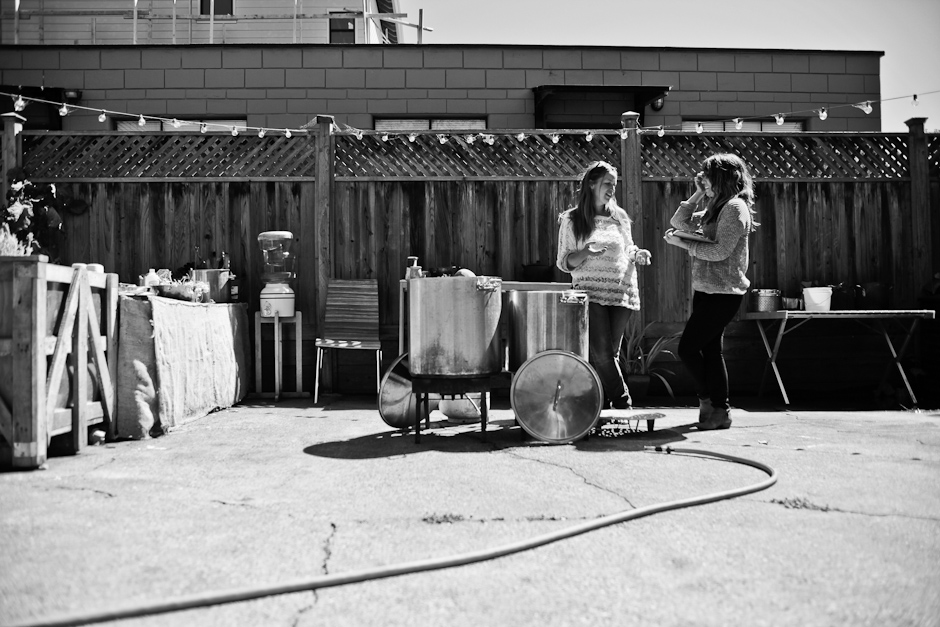



Are you involved in any upcoming shows or events? Where and when?
I was part of an epic and experimental show curated by David Wilson at the Berkeley Art Museum “The Possible” where we hosted a Plant Dye Lab all semester within the Museum itself. My CCA “Soil to Studio” Class experimented with medicinal plants, compost colors, and shared their final projects in the museum. I am looking forward to seeing the documentation and artist book coming out later this summer.
This summer I am part of a show on Re-imagining Paper and Fiber with University of Hawaii at Hilo (my hometown!). I just finished dyeing two large pieces with hibiscus hues (deep grays, purples and blacks) as well as a palette from aloe (yellows to pinks),
Permacouture always has collaborative workshops and events we look forward to sharing, including many place-based plant palette workshops and ongoing “Dinners to Dye For” as well as some neighborhood weed dye workshops. And a workshop on California colors from native plants is coming up at the Tilden Botanical Garden in September.

To see more of Sasha’s work:
www.permacouture.org
www.sashaduerr.tumblr.com
The New York Times
Selvedge Magazine
In Living Color-Video




